The Project: Optimizing the Onboarding Process of TribeScale
TribeScale is a web and mobile based team management platform, aiming to bring the agility and high-performance of start up teams to companies of all sizes.
Date: February 2017
Company: TribeScale
Team:
Alexis Roqué – Product Owner
Alberto Alcaraz – CEO
Daniel Gonzalez – CTO
Josean Muñoz – Marketing Manager
Gabriel Anglada – Developer
Hana Gausfain – UX & CS
Silvia Calvet – DS Master
The Challenge
On my very first day of joining the UX team in October 2016, I was introduced to one of the main pain points of the project: its onboarding process and user activation rate.
When you are dealing with a platform as complete as TribeScale, which includes communication channels, team and company level dashboards, and advanced features, making it easy for the user to understand where and how to start is a great challenge.
Acquisition and conversion rates on our webpage weren’t an issue, as users were attracted to our message. However, once registered, the rate of users who managed to invite their teams and use the app on a daily basis wasn’t as high as we desired.
In the following months we tried different strategies such as predefined tribe templates (high-performing teams are called tribes in the platform), welcome tribes and free demo sessions to try to encourage team activation. Finally in February 2017 we ran a Design Sprint focusing on the onboarding process to come up with a solid solution.
Step 1: Clarifying the Vision & User Personas

The first step in the Design Sprint was to clearly define our vision, user personas and value proposition.
I was in charge of running previous research and persona creation and present it to the group for discussion. We completed the research by contacting potential users to hear their story and adapt our message according to their needs.
We understood that our main target were managers controlling several teams or working remote, looking to empower their people while keeping on track of business.
We also reached some conclusions regarding the type of experience we wanted our users to live: team managers should feel guided and motivated to start using our app to improve their teams.
Step 2: Addressing Pain Points in the User Journey
As a UX responsible I also portrayed the user journey of managers signing up to TribeScale. The journey started with the registration to a TribeScale (TS) account, followed by the creation of a tribe which then finally led to the dashboard.
When arriving, some tooltips helped the users identify key areas of the dashboard and encouraged them to invite their teams or write a first message.
All users went through the same journey and were supposed to understand which was the best configuration for their team needs and discover advanced features on their own.
Unless they reached out to us by asking for support, there was no guidance towards setting up the tribe according to their particularities and needs.

Step 3: Defining a new User Journey
According to our new design principles, we worked on designing a new onboarding flow that was guiding, educational, and motivating.
We focused on our 3 main functionalities and their benefits (structured communication, automatic reporting, and shared goals) and offered three different onboarding flows according to our user’s main needs.
The idea was both to understand what was the main motivation of our potential customers and to provide insight into how the app could help meet their needs in a few minutes.
After following the account setup wizard, the users arrived at the main dashboard and they were able to see right away the results of what they had been building.
I worked mainly on adapting the content of the homepage and copywriting the different screens of the new onboarding flow.

Step 4: User Testing and Iteration
Once we had our new mockups ready with Sketch, we put together an interactive prototype with Invision. We invited some potential users and I took part in the testing to check the new onboarding flow and gather feedback.
This allowed us to improve our designs, such as clearly showing the specific questions that would be sent in the “Effective alignment” path. And also we removed the screen that asked to send team invitations, as users preferred to see first how the actual dashboard would look like.
On the other hand, we confirmed our hypothesis that allowing the user to choose a particular factor they wanted to improve in their team and seeing how the app could help them in that issue specifically was motivating to start using the platform.

Mockups














